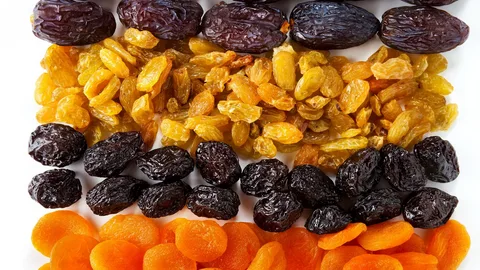Raisins, sultanas, and currants are all dried fruits that are commonly used in cooking, baking, and snacking. While they may appear similar, there are distinct differences among these dried fruits in terms of their taste, texture, and production methods. In this comprehensive guide, we will explore the differences between raisins, sultanas, and currants, their characteristics, and their culinary uses.
Raisins:
Raisins are dried grapes, typically made from larger grape varieties such as Thompson seedless or Muscat. The grapes are allowed to ripen on the vine until they reach their full sweetness. Then, they are harvested and laid out to dry in the sun or mechanically dried. Raisins have a dark brown color, a wrinkled texture, and a sweet flavor. They are commonly used in baked goods, breakfast cereals, trail mixes, and as a topping for salads or desserts.
Sultanas:
Sultanas are also dried grapes, but they come from seedless grape varieties known as Sultana grapes. These grapes are usually smaller and sweeter than regular grapes. Sultanas are produced by drying the grapes on the vine or by artificial drying methods. They have a golden-yellow color, a softer texture compared to raisins, and a sweet and tangy flavor. Sultanas are often used in baking, particularly in cakes, cookies, and fruit bread. They can also be enjoyed as a standalone snack or added to breakfast dishes like oatmeal or yogurt.
Currants:
Currants, unlike raisins and sultanas, are not dried grapes. They are small, seedless berries that come from the dried fruits of various species of the Ribes plant, typically the black currant or red currant. Currants have a deep, dark color, ranging from black to dark red, and they have a slightly tart and tangy flavor. Currants are commonly used in baking, particularly in cakes, muffins, and scones. They can also be used in jams, jellies, and as a topping for desserts or added to savory dishes like salads or rice pilaf.
Differences in Taste and Texture:
The main differences among raisins, sultanas, and currants lie in their taste and texture. Raisins have a rich and sweet flavor with a chewy texture, while sultanas have a sweeter and slightly tangy flavor with a softer texture. Currants, on the other hand, have a more tart and tangy flavor compared to raisins and sultanas, and they are firmer in texture.
Culinary Uses:
Each of these dried fruits has its own unique culinary uses. Raisins are versatile and can be used in a wide range of dishes, including baked goods, savory recipes, and as a topping for salads or cereals. Sultanas are commonly used in baking, particularly in sweet treats like cakes, cookies, and puddings. They can also be enjoyed on their own as a snack or added to breakfast dishes. Currants are popular in baking, especially in traditional recipes like fruitcakes, scones, and tarts. They are also used in jams, jellies, and sauces to add a tangy flavor.
Nutritional Value:
In terms of nutritional value, raisins, sultanas, and currants are all good sources of dietary fiber, antioxidants, and certain vitamins and minerals. They are relatively low in fat and cholesterol-free. However, it’s important to note that dried fruits are more concentrated in calories compared to their fresh counterparts, so portion control is important, especially for those watching their calorie intake.
Choosing and Storing:
When purchasing raisins, sultanas, or currants, look for products that are free from additives or preservatives. Opt for organic varieties if available. It’s also important to store these dried fruits in a cool, dry place in airtight containers to maintain their freshness and prevent them from becoming hard or overly dry.
Conclusion:
Raisins, sultanas, and currants are all delicious and versatile dried fruits that can add flavor, texture, and nutritional value to a variety of dishes. While they may have subtle differences in taste, texture, and culinary uses, they can often be used interchangeably in recipes. Whether you’re baking a cake, preparing a trail mix, or simply enjoying them as a snack, these dried fruits provide a sweet and nutritious addition to your diet. Experiment with each variety to discover your personal preferences and enjoy the unique flavors and textures they offer.
- Sipping Sunshine: A Taste Adventure with Melo’s THC Beverages - May 13, 2024
- Unleashing the Potential of Lion’s Mane Functional Mushrooms: A Comprehensive Guide to Their Benefits - October 18, 2023
- Sweet Bliss Unleashed: Navigating the Rainbow of Delta 10 THC Gummies from Just Delta - September 11, 2023





